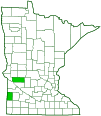green soldier fly
(Hedriodiscus binotatus)
Conservation • Description • Habitat • Ecology • Distribution • Taxonomy
Conservation Status |
|
|||||||
| IUCN Red List | not listed |
|||||||
| NatureServe | NNR - Unranked |
|||||||
| Minnesota | not listed |
|||||||
Description |
||
Green soldier fly is a large, wasp-like, soldier fly. It occurs in southern Canada, the United States, and northern Mexico. The larvae are aquatic, and adults are always found near water. Adults are ⅜″ to ⅝″ (10 to 15 mm) in length. On the female, the head is more or less hemispherical. There are two large compound eyes on the side of the head and three small but prominent simple eyes (ocelli) in a triangle at the top of the head. The compound eyes are widely separated at the top of the head. The face is green. The forehead (frons) is green with a wavy black horizontal line above the antennae bases. The top of the head (vertex) is green except for a large, oval, black area around the ocelli. The antennae are long (for a fly) and are inserted just above the middle of the face. They have three segments. The first two segments are reddish-brown, the third segment is black, at least at the tip, and is divided into five ring-like segments (annulated). It does not have a bristle-like appendage (arista). The thorax is black above and green on the sides, with two green spots in the middle. This is the feature that gives the fly the species epithet binotatus, meaning “twice-marked”. The spots are highly variable in size, from elongate and almost reaching the rear margin, to round and tiny. On some individuals the spots are inconspicuous or missing. The exoskeletal plate between the wing bases (scutellum) is green and has two yellowish spines. The abdomen is green with a black band at the base of each segment. The width of the bands is variable, sometimes dilated in the middle and meeting the band on an adjacent segment. The underside of the abdomen is entirely green. The legs are moderately long and mostly reddish-brown. On each leg the base of the third segment (femur) and the base of the fourth segment (tibia) are yellow. The wings are clear with brownish-yellow veins. Three veins of equal length extend from the discal cell. There are five distinct cells at the outer part of the wing. The radial vein (R) has two branches, and they are crowded in the front of the wing. The posterior branch (Rs) has three branches. The posterior branch of Rs (R5) ends at the margin before the wing tip. The anal cell is longer than the second basal cell and is closed near the wing tip. On the male, the compound eyes meet at the top of the head. The face is entirely green with no black markings. On the front legs, the tip of the femur, the base of the tibia, and the last part of the leg (tarsus), corresponding to the foot, are black. |
||
Size |
||
Total length: ⅜″ to ⅝″ (10 to 15 mm) |
||
Similar Species |
||
Habitat |
||
|
||
Ecology |
||
Season |
||
|
||
Behavior |
||
Larvae live in water. Adults are found on flowers. |
||
Life Cycle |
||
|
||
Larva Food |
||
|
||
Adult Food |
||
|
||
Distribution |
||||
|
Sources |
|||
| 8/24/2023 | ||||
Occurrence |
||||
|
||||
Taxonomy |
|||
Order |
Diptera (Flies) | ||
Suborder |
Brachycera | ||
| Infraorder | Orthorrhapha | ||
| Parvorder | Stratiomyomorpha (soldier flies and allies) | ||
| Superfamily | Stratiomyoidea | ||
Family |
Stratiomyidae (soldier flies) | ||
Subfamily |
Stratiomyinae | ||
Tribe |
Stratiomyini | ||
Genus |
Hedriodiscus | ||
Species group |
|||
Synonyms |
|||
Odonotmyia bicolor Odontomyia binotata Odontomyia innotata Odontomyia truquii var. innotata |
|||
Common Names |
|||
| green soldier fly | |||
Glossary
Arista
A large bristle on the upper side of the third segment of the antenna of a fly. Plural: aristae.
Femur
On insects and arachnids, the third, largest, most robust segment of the leg, coming immediately before the tibia. On humans, the thigh bone.
Frons
The upper front part of an insect’s face, roughly corresponding to the forehead.
Ocellus
Simple eye; an eye with a single lens. Plural: ocelli.
Scutellum
The exoskeletal plate covering the rearward (posterior) part of the middle segment of the thorax in some insects. In Coleoptera, Hemiptera, and Homoptera, the dorsal, often triangular plate behind the pronotum and between the bases of the front wings. In Diptera, the exoskeletal plate between the abdomen and the thorax.
Tarsus
On insects, the last two to five subdivisions of the leg, attached to the tibia; the foot. On spiders, the last segment of the leg. Plural: tarsi.
Tibia
The fourth segment of an insect leg, after the femur and before the tarsus (foot). The fifth segment of a spider leg or palp. Plural: tibiae.
Vertex
The upper surface of an insect’s head.
Visitor Photos |
|||||
Share your photo of this insect. |
|||||
| This button not working for you? Simply email us at info@MinnesotaSeasons.com. Attach one or more photos and, if you like, a caption. |
|||||
Babette Kis |
|||||
Hedriodiscus binotatus group soldier fly with brown and green abdomen Hedriodiscus binotatus group, soldier fly with green abdomen and brown markings, on Canada wild rye grass. Barnes Prairie, Racine County, WI, July 16, 2021. |
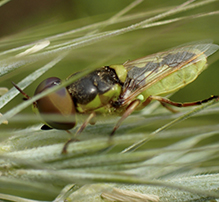 |
||||
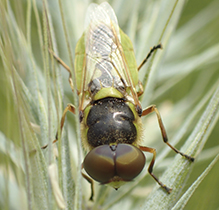 |
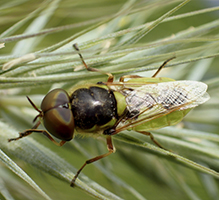 |
||||
MinnesotaSeasons.com Photos |
|||||
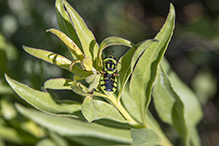 |
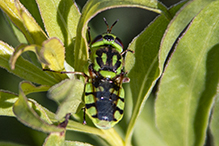 |
||||
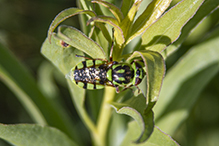 |
|||||

Slideshows |
||

Visitor Videos |
|||
Share your video of this insect. |
|||
| This button not working for you? Simply email us at info@MinnesotaSeasons.com. Attach a video, a YouTube link, or a cloud storage link. |
|||
Other Videos |
|||


Created: 6/20/2023
Last Updated:
